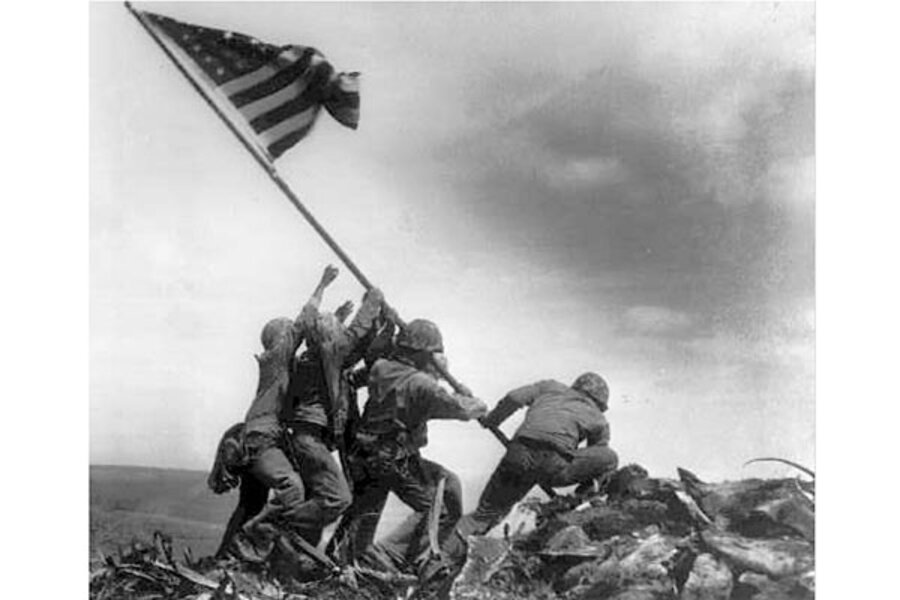From Our Files: Iwo Jima, Feb. 23, 1945
Loading...
| ADVANCE PACIFIC FLEET HEADQUARTERS, Guam. Via Navy Radio, Feb. 23
With Mt. Suribachi now in the possession of the United States Marines at a cost of 5,372 casualties, the invaders at last have a substantial foothold and the technical advantage of their first high terrain.
That the Japanese were able to withstand the persistent and terrific preinvasion bombardment of Iwo and yet put up the toughest resistance experienced anywhere in the Pacific is proof that they mean to fight tenaciously for every inch of the Island.
The toughness of this island fortress is emphasized in figures released by Admiral Chester W. Nimitz covering bomb and shell tonnages expended prior to the landings.
PREINVASION ASSAULT
During the 72 days between December 7 and February 19, Iwo Jima was subjected to a furious air and sea assault which is believed to have set a record for this type of attack.
In five naval bombardments, exclusive of the final preinvasion ship-to-shore barrage, surface forces fired 2,100 tons of explosives into the tiny isle. In daily consecutive air raids, Army Liberators dropped approximately 6,000 tons of bombs of various types. Five raids by Superforts of the 21st Bomber Command added an estimated 1,500 tons of bombs.
OTHER BOMBINGS
In the final bombardment, and in the ships' artillery support through Feb. 20, battleships, cruisers, and destroyers fired an additional 8,000 tons.
To this now could be added the tremendous weight of bombs dropped by carrier planes, thousands of rockets unleashed from planes and gunboats, plus shells fired by ships, as well as by heavy artillery landed within 36 hours after the beachhead was established.
A conservative estimate would be that at least 20,000 tons of high explosives were poured into the island, which is a little more than eight square miles in area - about 2,500 tons a square mile.
No wonder reconnaissance photos, even before invasion, could show 5,000 bomb craters within an area of one square mile.
Devastating as this assault has been, craters are not the entire measure of permanent damage. Kiska and Tarawa were notable among the numerous examples of how sandy or absorbent soil, combined with reinforced dug-in defenses, can modify or nullify the effect of persistent bombing and bombardment.
At least part of the reason for the unusually high effectiveness of bombing and bombardment at Roi and Namur in the Marshalls lay in the fact that the Japanese were caught with their defenses unfinished. It was estimated that one third to one half of the Roi and Namur defenders were killed before the invasion bombardment.
IWO NATURAL FORTRESS
As is more often the case with Japanese island forts, Iwo Jima was strongly prepared. Judging from reports so far, this gritty volcanic rock combines many of the worst features of Tarawa's pillboxes and Saipan's terrain.
Although Iwo Jima's 500 - 600-foot Suribachi Yama crater is only about one third as high as Saipan's Mt. Tapotchau, Iwo's rugged formations of terraces and rocky bluffs offer positions which give the defender every advantage.
The Tarawa battle lasted 72 hours at a cost of 3,000 United States casualties, including 1,000 killed. Tarawa casualties were about 20 percent of the total Marine attacking force. Makin, which was simultaneously won, cost less than 200 casualties, including about 60 killed.
Saipan's 72 square miles of mountainous terrain were taken in 24 days by one army and two Marine divisions. United States casualties amounted to more than 25 percent of the Marines and Army troops involved.
But the gains were very great. Saipain, Guam, and Tinian furnished the needed system for B-29 bases, plus the advance headquarters from which the remainder of the Central Pacific war could be fought.
Gains represented by conquering Iwo Jima already have been presented in considerable detail. By converting this link of the inner Japanese defense chain into an advance base of the American offensive system, fight coverage can be given to B-29s attacking Japan, relieving defending fighters and antiaircrft weapons on Saipan for uses elsewhere.
Poor in anchorage facilities and without a harbor, Iwo Jima can hardly serve for amphibious staging purposes. But it it expected to justify its high cost.
###







